The messy, marvelous journey from modems to machine minds
Table of Contents
- Intro: Clunky Clicks to AI Tricks
- The Early Clicks (1998–2001)
- Google Grows Up (2002–2005)
- Social Sparks (2006–2008)
- Panda, Penguin & Pain
- Mobile First & Video Boom
- The Data & Privacy Era
- Pandemic Push & Digital Boom
- AI Gobbles up the Internet
- Then vs Now: Gains & Losses
- The Unwritten Road Ahead
- FAQ: History of the Internet
Clicking Back in Time: The Start of the History of the Internet
The History of the Internet’s early days — dial-up tones, clunky design, and the birth of Google
If you’ve been around long enough to remember the hiss-screech of a dial-up modem, you’ve lived through some of the most fascinating years in the history of the internet. Back in 1998, the web was clunky, chaotic, and gloriously unpredictable. I remember staring into the screen for hours, trying to figure this stuff out — clicking, tweaking, and breaking things just to see what would happen.
Websites were cobbled together in Microsoft FrontPage or Dreamweaver, where “cool” meant flashing GIFs, scrolling text, and maybe a visitor counter at the bottom. If you wanted to be found online, you submitted your site to search engines manually — one form at a time.
Google had just arrived, quietly rewriting the search history book before most of us even knew what PageRank meant. SEO back then was laughably simple — repeat your keywords until your fingers hurt, and you were set. Social media didn’t exist. The closest thing was an MSN Messenger ping or dropping a post in a Yahoo! chatroom, hoping someone on the other side of the world would reply.
Fast forward to today, and the web couldn’t be more different. Mobile-first design, AI-powered search, and instant global communication have replaced the slow, messy charm of those early days. And now, AI and the future of the internet is rewriting the rules again — shifting how we create, share, and interact online in ways that make even the dot-com boom feel slow.
This is the story of how we went from clunky clicks to AI tricks — and what we gained, lost, and learned along the way.
The Early Clicks (1998–2001)
The History of the Internet before social media and smartphones
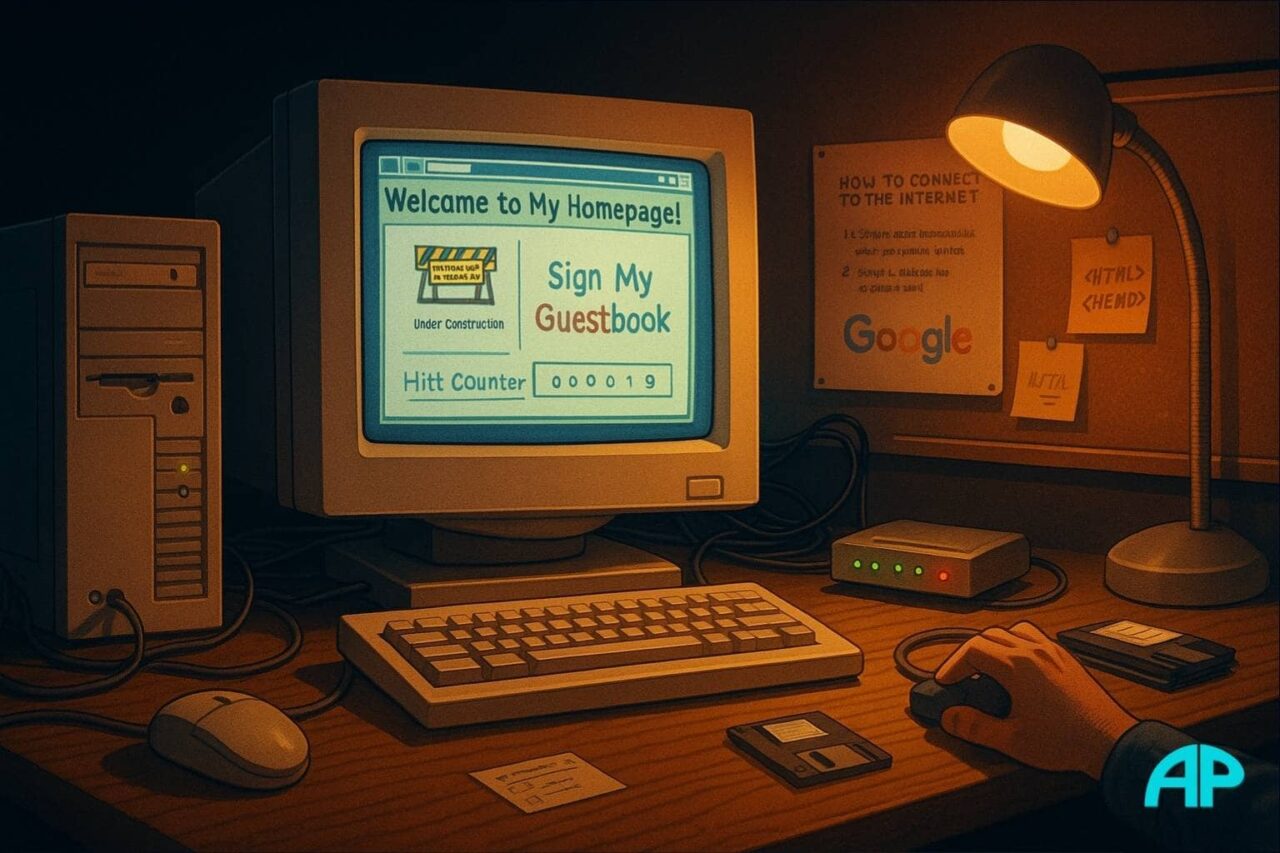
If you want to really appreciate the history of the internet, you’ve got to remember what life online looked like at the end of the 90s. There were no notifications, no instant streaming, no addictive social feeds. You’d power up a chunky desktop, wait for the modem to screech through its connection dance, and finally, after what felt like forever, a static web page would load — probably with flashing GIFs and a hit counter at the bottom.
The Evolution of Web Design in Its Infancy
This was the era of Microsoft FrontPage and Macromedia Dreamweaver — the training wheels of the evolution of web design. If you could write HTML, you were practically a sorcerer. Sites were built with garish backgrounds, multi-coloured fonts, and page layouts that made no sense. Accessibility? Never heard of it. Mobile-friendly? Didn’t exist — unless you count printing the page and reading it on the bus.
Google Search History Begins
In September 1998, two Stanford students, Larry Page and Sergey Brin, launched a clean, no-frills search engine called Google. At first, hardly anyone noticed, but it quickly became a bookmark worth keeping. This was the start of Google search history — and it changed everything. Suddenly, finding something online wasn’t about clicking endlessly through Yahoo! directories. You could type in a phrase and (mostly) get what you were looking for.
The Early Days of SEO: Anything Goes
The early days of SEO were gloriously messy. Want to rank? Repeat your keywords until your fingers hurt. Hide them in white text on a white background so only Google’s bots saw them? Genius. Submit your site to “1,000 search engines” with a $19.99 CD-ROM? Absolutely. Backlinks were optional, content quality was irrelevant, and yet somehow, people still found what they were after.
It was a web built by enthusiasts, not corporations. Every site had a personal touch, whether it was a fan page for your favourite band or a blog about your pet turtle. Looking back now, those first years in the history of the internet feel raw, experimental, and weirdly magical — a kind of digital frontier before the rules, ads, and algorithms took over.
Google Grows Up (2002–2005)
The History of the Internet enters its first big growth spurt
By the early 2000s, the history of the internet had already taken its first major turn. Google was no longer the scrappy new kid on the block — it was becoming the front door to the entire web. More and more people were “Googling” (a verb now) instead of digging through cluttered directories. And businesses? They were starting to realise that if you could appear on that first page of search results, you had a gold mine.
Google Search History Takes Off
In 2002, Google AdWords began to gain serious traction. Suddenly, you could pay to appear at the top of the results page — something that seemed revolutionary at the time. This marked a huge chapter in Google search history, where search results started to blend organic listings with ads. By 2005, Google Analytics arrived, giving website owners a crystal ball into visitor behaviour.
The Evolution of Web Design Becomes More Professional
The evolution of web design was shifting fast. Tables and frames were giving way to cleaner, CSS-driven layouts. Businesses started caring about branding, typography, and usability. A good website wasn’t just a digital brochure anymore — it was a lead-generating machine. And if you could design one that loaded quickly on a dial-up connection? You were a hero.
The Early Days of SEO Get Smarter
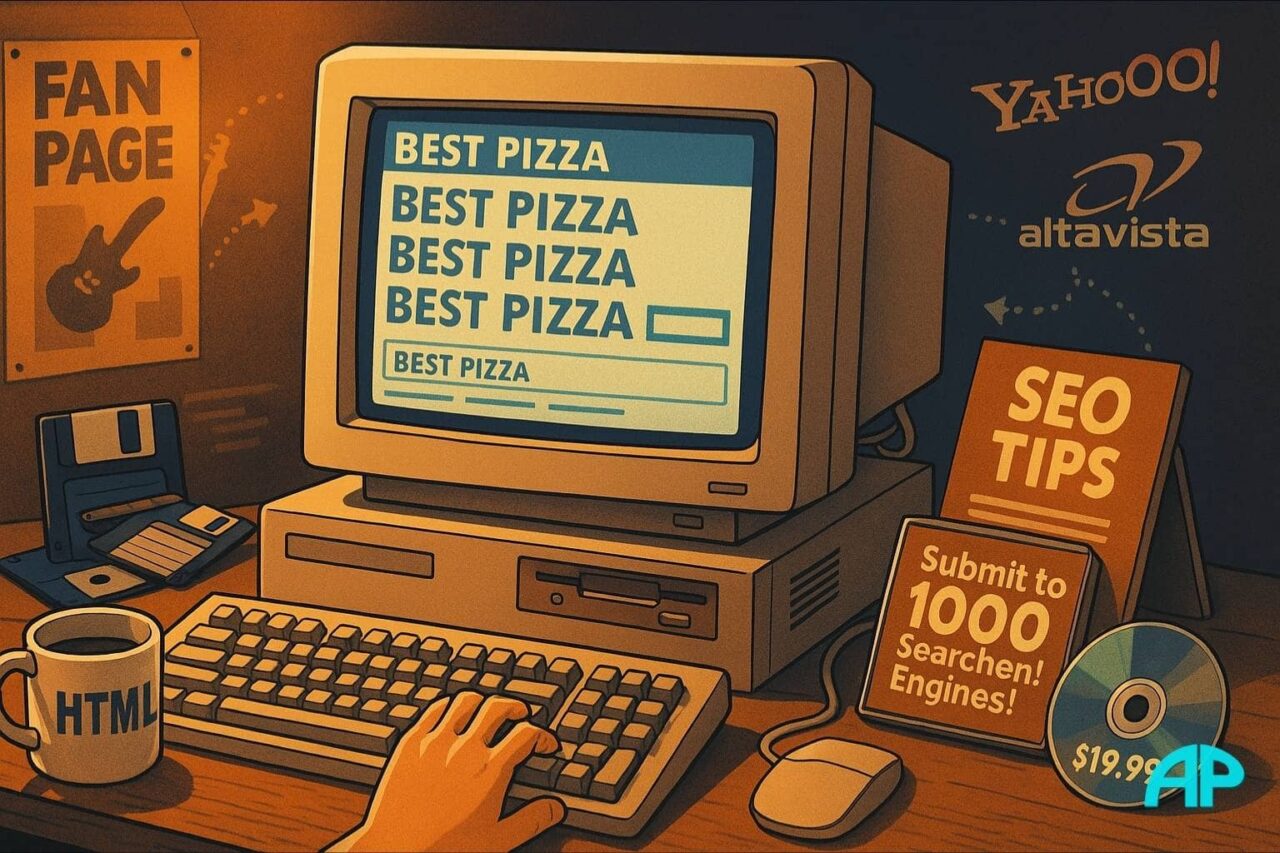
The early days of SEO weren’t over yet, but they were starting to grow up. Google’s Florida Update in 2003 changed the game by cracking down on spammy keyword stuffing and irrelevant backlinks. For the first time, SEO wasn’t just about gaming the system — it was about understanding it. The rules were still flexible, but the days of ranking overnight for “free money” were fading fast.
The internet was maturing. The wild, anything-goes vibe of the late 90s was giving way to a more structured, commercial environment. Google was setting the rules, web design was finding its footing, and SEO was evolving into a skill set rather than a gimmick. The history of the internet was moving quickly — and the next big disruption was already on the horizon: social media.
Social Sparks (2006–2008)
The History of the Internet meets the rise of social media platforms
By the mid-2000s, the history of the internet took another sharp turn — one that would change how we interact online forever. This was the dawn of the social era. Up until now, the web had been a one-way street: you visited sites, you consumed content, maybe you left a comment on a blog if you were feeling bold. But in 2006, everything shifted toward connection, interaction, and sharing.
The Rise of Social Media Platforms
In 2006, Facebook opened to the public. YouTube had just been acquired by Google, setting the stage for its video domination. Twitter (then known for its 140-character limit) started chirping into our feeds. This was the true rise of social media platforms — and suddenly, the internet wasn’t just about information, it was about conversation.
Friends reconnected, strangers became online besties, and memes started spreading faster than chain emails ever could. For businesses, social media was an untapped goldmine. You could promote your brand, engage directly with customers, and — if you were lucky — go viral.
The Evolution of Web Design Goes Social
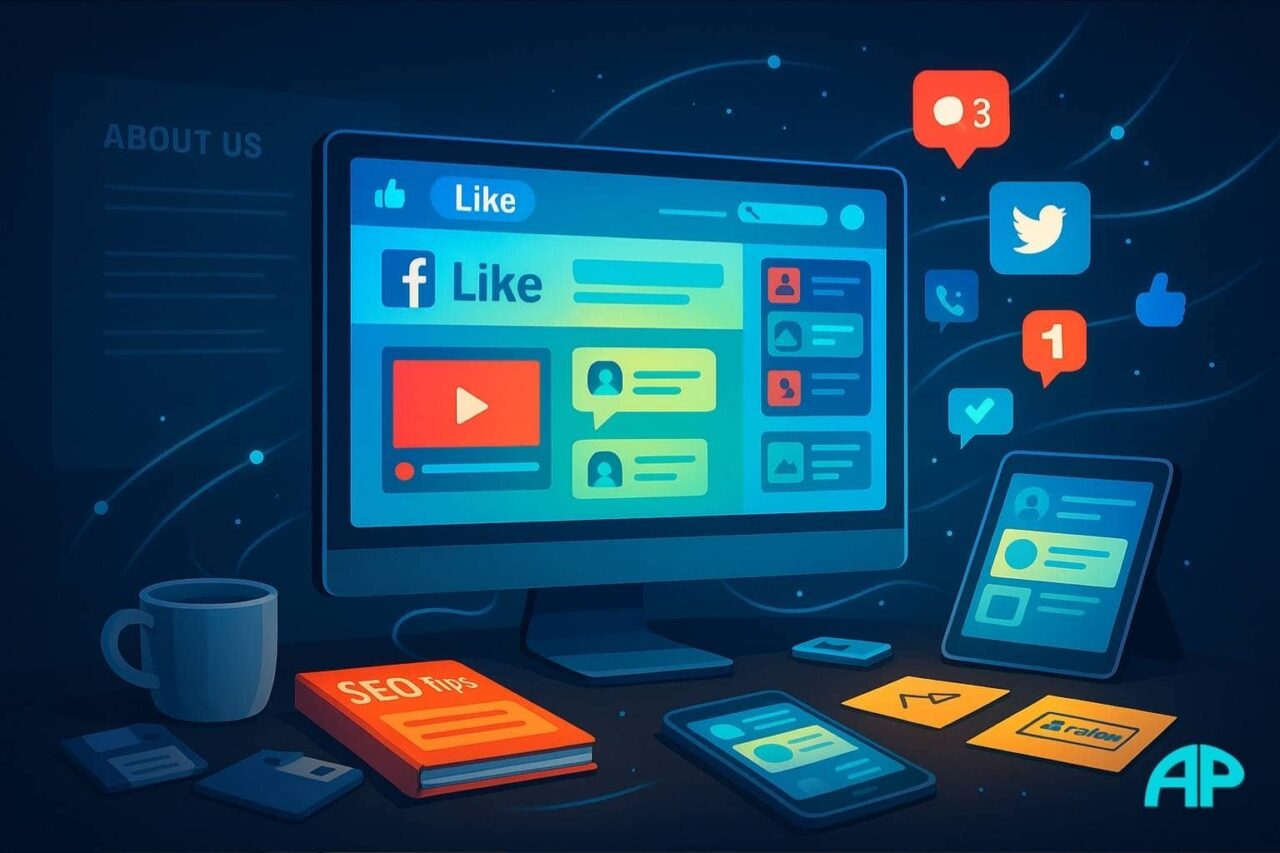
The evolution of web design followed suit. Websites started embedding social widgets, share buttons, and live feeds. Video players popped up on homepages, and comment sections became standard. Design began catering to engagement, not just information delivery. The old static “About Us” page was now competing with real-time conversations happening on your social channels.
Early Days of SEO Adapt to the Social Shift
The early days of SEO were starting to feel distant. Ranking in Google still mattered, but now you also had to think about how your brand appeared on Facebook and YouTube. Video optimisation became a thing, and sharing content across networks could boost your visibility just as much as traditional backlinks.
This period in the history of the internet was electric. Every month seemed to bring a new platform, a new feature, or a new way to connect. The web was becoming more personal, more interactive, and more addictive. But just as social media was hitting its stride, Google was about to shake things up again — and not everyone would survive the changes.
Panda, Penguin & Pain (2009–2012)
The History of the Internet gets a brutal SEO reality check
By 2009, the history of the internet had moved far beyond the wild-west vibe of its early years. Businesses were pouring money into their online presence, SEO agencies were popping up everywhere, and the rise of social media platforms meant brands could now reach millions instantly. But just as everyone thought they had the game figured out, Google came in with the hammer.
Google Search History Hits Hard with Algorithm Updates
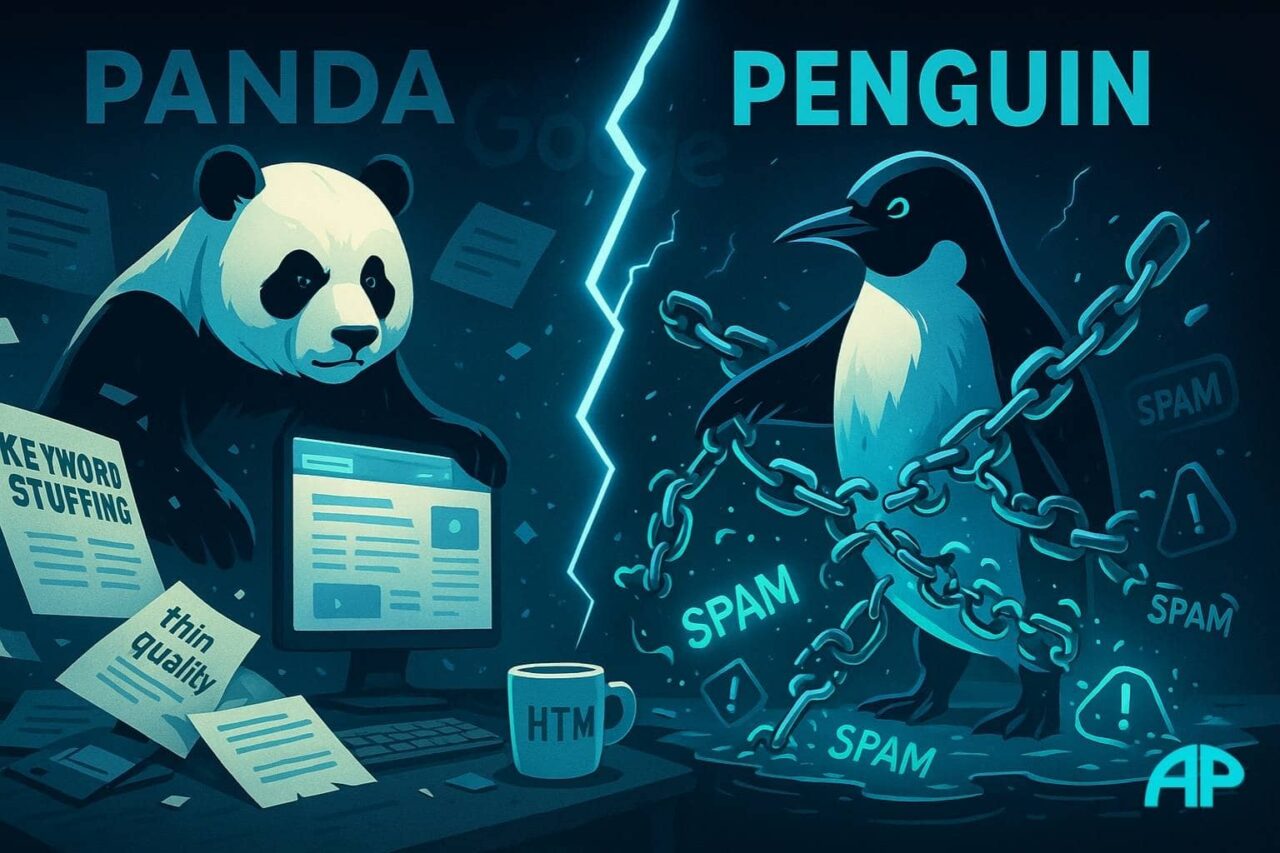
In 2011, the Panda update landed. This was one of the most significant shifts in Google search history. Panda targeted thin, low-quality content — the kind that existed solely to rank for keywords but offered zero value to readers. Overnight, sites that had been raking in traffic saw their rankings crumble.
Then came Penguin in 2012. If Panda was about content quality, Penguin was about links. Sites that had built their rankings on dodgy link farms, spammy blog comments, or irrelevant backlinks were obliterated. For many, it was like watching years of work vanish overnight.
The Evolution of Web Design Becomes User-Centric
The evolution of web design during this era shifted toward trust and usability. Websites had to look credible, load fast, and work seamlessly. The focus moved from flashy animations to cleaner layouts, mobile compatibility, and better navigation. Google wasn’t just ranking based on keywords anymore — it was rewarding sites that delivered a good user experience.
Early Days of SEO Are Officially Over
The early days of SEO, with their keyword stuffing and spammy backlink strategies, were now dead. To succeed, you had to produce genuinely valuable content, attract natural links, and understand user intent. It was the start of content marketing as we know it today.
The Panda and Penguin years were a turning point in the history of the internet. They separated the opportunists from the strategists, forcing website owners to either level up or disappear. And while Google was cracking down on bad SEO, another wave was building — one that would reshape the web for the mobile generation.
Mobile First & Video Everywhere (2013–2016)
The History of the Internet shifts to mobile-first and video-driven content
By 2013, the history of the internet had entered its next big transformation. Smartphones weren’t just common — they were becoming the primary way people accessed the web. If your site didn’t work on mobile, you were invisible. Google made it official in 2015 when it rolled out mobile-first indexing, ranking mobile-friendly sites higher. For many businesses, it was either adapt or vanish.
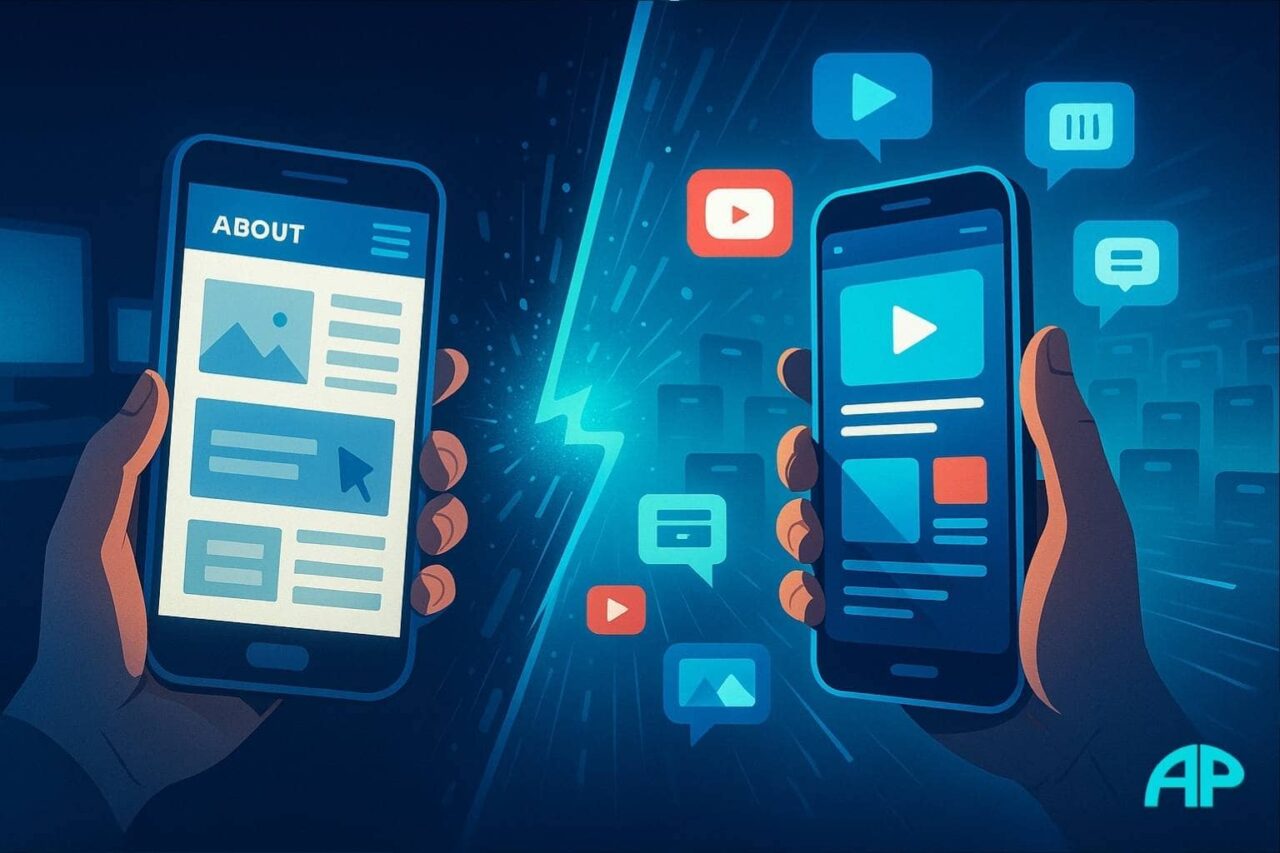
The Evolution of Web Design Goes Responsive
The evolution of web design in this era was dominated by responsive design. Instead of building separate desktop and mobile sites, developers started creating layouts that adapted automatically to any screen size. Minimalist menus, touch-friendly buttons, and lightning-fast load times became the norm. Design was now about simplicity, speed, and clarity — because mobile users didn’t have the patience for clutter.
Video Becomes the Web’s Favourite Language
This was also when video exploded online. YouTube was fully mainstream, Facebook was prioritising video in its feeds, and new players like Vine and Snapchat were introducing the short-form, snackable video trend. Instagram jumped in with video posts and later Stories. The rise of social media platforms was now inseparable from the rise of video itself.
Google Search History and SEO Adapt to Voice and Video
Google search history in this period shows a shift toward new search behaviours. Voice search was on the rise thanks to Siri, Google Now, and Alexa. SEO strategies had to evolve — optimising for conversational queries, transcribing videos, and creating video-friendly content became essential. The early days of SEO were long gone; this was the age of multimedia optimisation.
In just a few short years, the history of the internet had gone from static pages to a mobile-first, video-saturated environment. And just as businesses were getting used to this new reality, the next wave of change was already rumbling — one driven by privacy concerns, data scandals, and a growing distrust of big tech.
The Data & Privacy Era (2017–2019)
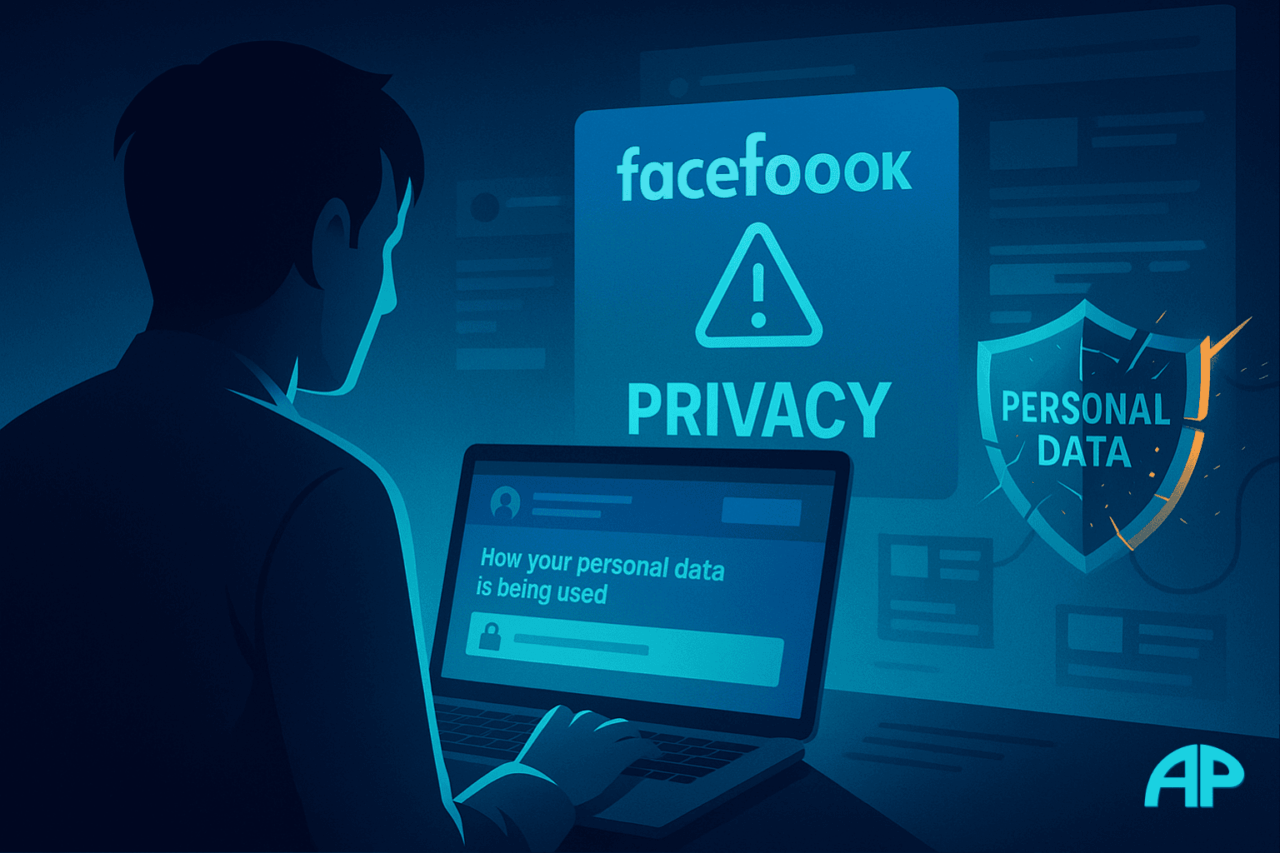
The History of the Internet faces its trust crisis
By the late 2010s, the history of the internet was no longer just about speed, design, and rankings — it was about trust. People had become increasingly aware of how much data they were handing over to tech giants, often without realising it. The tipping point came in 2018 with the Cambridge Analytica scandal, where Facebook data was used to influence political campaigns. Overnight, privacy wasn’t just a niche concern — it was headline news.
Google Search History Reflects a Shift in Intent
During this period, Google search history shows a trend toward “how to delete my account” and “privacy settings” queries. Google itself began emphasising search intent over exact keyword matches, meaning SEO strategies had to dig deeper into why people were searching, not just what they were typing.
The Evolution of Web Design Goes Minimal and Secure
The evolution of web design in these years leaned heavily on simplicity, speed, and trust signals. HTTPS became a ranking factor, so sites scrambled to install SSL certificates. Privacy policies were no longer fine print at the bottom of a page — they were front and centre, often thanks to regulations like GDPR. Designs became cleaner, faster, and less cluttered, partly to improve usability, partly to avoid looking spammy.
The Rise of Social Media Platforms Loses Its Shine
While the rise of social media platforms had dominated the previous decade, cracks were starting to show. User growth slowed in some regions, and the platforms faced criticism for spreading misinformation and not doing enough to protect user data. People began looking for alternatives, from private messaging apps to smaller, niche networks.
By the end of 2019, the history of the internet was standing at a crossroads: the convenience of always-on connectivity versus the growing desire for privacy and control. And then, in early 2020, the world changed — and so did the web.
Pandemic Push & Digital Explosion (2020–2021)
The History of the Internet becomes the world’s lifeline
When COVID-19 hit in early 2020, the history of the internet entered one of its most intense and transformative chapters. Practically overnight, our entire lives shifted online. Work meetings? Zoom. Family catch-ups? Zoom. School lessons? Zoom again. The web wasn’t just a convenience anymore — it was the glue holding society together.
The Rise of Social Media Platforms Hits Warp Speed
With lockdowns keeping people indoors, the rise of social media platforms went into overdrive. TikTok surged from a niche app to a global powerhouse, Instagram launched Reels to compete, and YouTube became the home of everything from pandemic updates to home workout tutorials. Social media wasn’t just for entertainment — it became a main source of news, community, and, for many, income.
Google Search History Mirrors the Shift
The Google search history of this period tells the story clearly: “how to bake bread,” “how to cut your own hair,” and “best webcam” were suddenly trending worldwide. Local searches skyrocketed, with people looking for nearby delivery options, online classes, and remote services. SEO strategies had to pivot fast, focusing on relevance, trust, and meeting urgent needs.
The Evolution of Web Design Meets Urgency
The evolution of web design during the pandemic was all about speed — not just site speed, but launch speed. Businesses that had never sold online scrambled to build e-commerce stores. Restaurants threw up takeaway menus overnight. Web design became leaner, more practical, and more conversion-focused, with clear calls-to-action and simplified checkout processes.
By the end of 2021, the history of the internet had been permanently altered. The shift to remote everything wasn’t going away, and the pace of change had accelerated like never before. And right on cue, a new player was stepping up to reshape the web again — AI.
AI Eats the Internet (2022–Present)
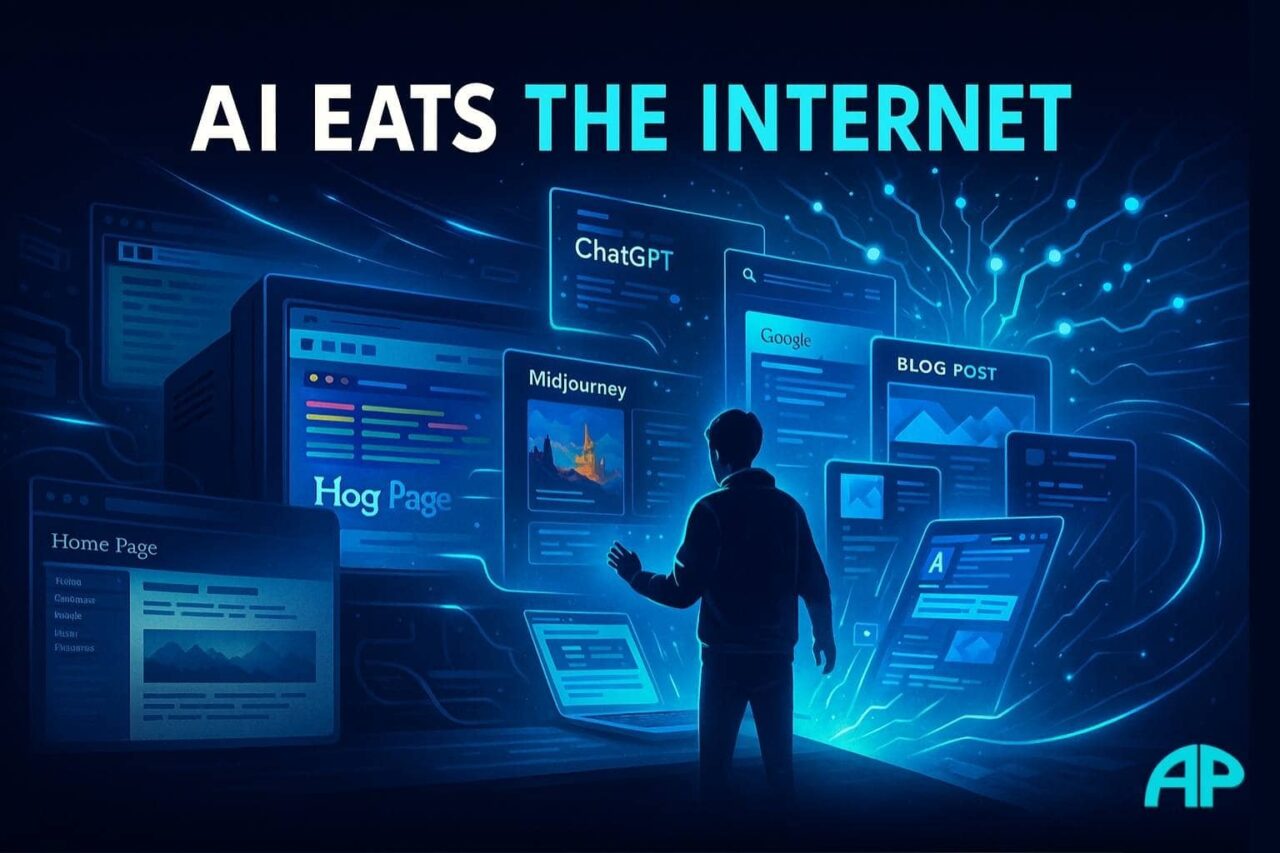
The History of the Internet enters the AI age
If the pandemic was a fast-forward button for digital adoption, 2022 was when someone hit turbo. This was the moment AI and the future of the internet stopped being a tech conference talking point and became part of everyday life. Tools like ChatGPT, Midjourney, and DALL·E dropped into the public’s hands, and suddenly, anyone could generate convincing text, stunning images, or even videos in seconds.
AI Reshapes the Evolution of Web Design
The evolution of web design took another leap. No-code builders integrated AI to auto-generate layouts, write copy, and even produce brand imagery. Tasks that once took designers hours could now be done in minutes. For some, AI became the ultimate creative assistant. For others, it felt like the soul of design was being replaced by algorithms.
Google Search History in the AI Era
A glance at Google search history over the last two years shows just how quickly the landscape shifted: “AI writing tools,” “AI image generator,” and “how to use ChatGPT” dominated search trends. Even SEO itself began to change, with AI tools helping write blog posts, suggest keywords, and analyse competitors faster than ever before. The line between “content creator” and “AI prompt engineer” started to blur.
The Rise of Social Media Platforms Gets AI Superpowers
The rise of social media platforms entered a new phase as AI began curating feeds, auto-editing videos, and even generating influencer-style avatars that weren’t real people. Some creators embraced AI to scale their content, while others worried about being drowned out by bots that never sleep.
The history of the internet has always been shaped by big technological shifts — search engines, social media, mobile. But AI feels different. It’s not just a new feature in the toolbox; it’s a fundamental rewrite of how we create, share, and consume information. Whether that’s exciting or terrifying depends on how ready we are for what comes next.
Then vs Now – Gains & Losses
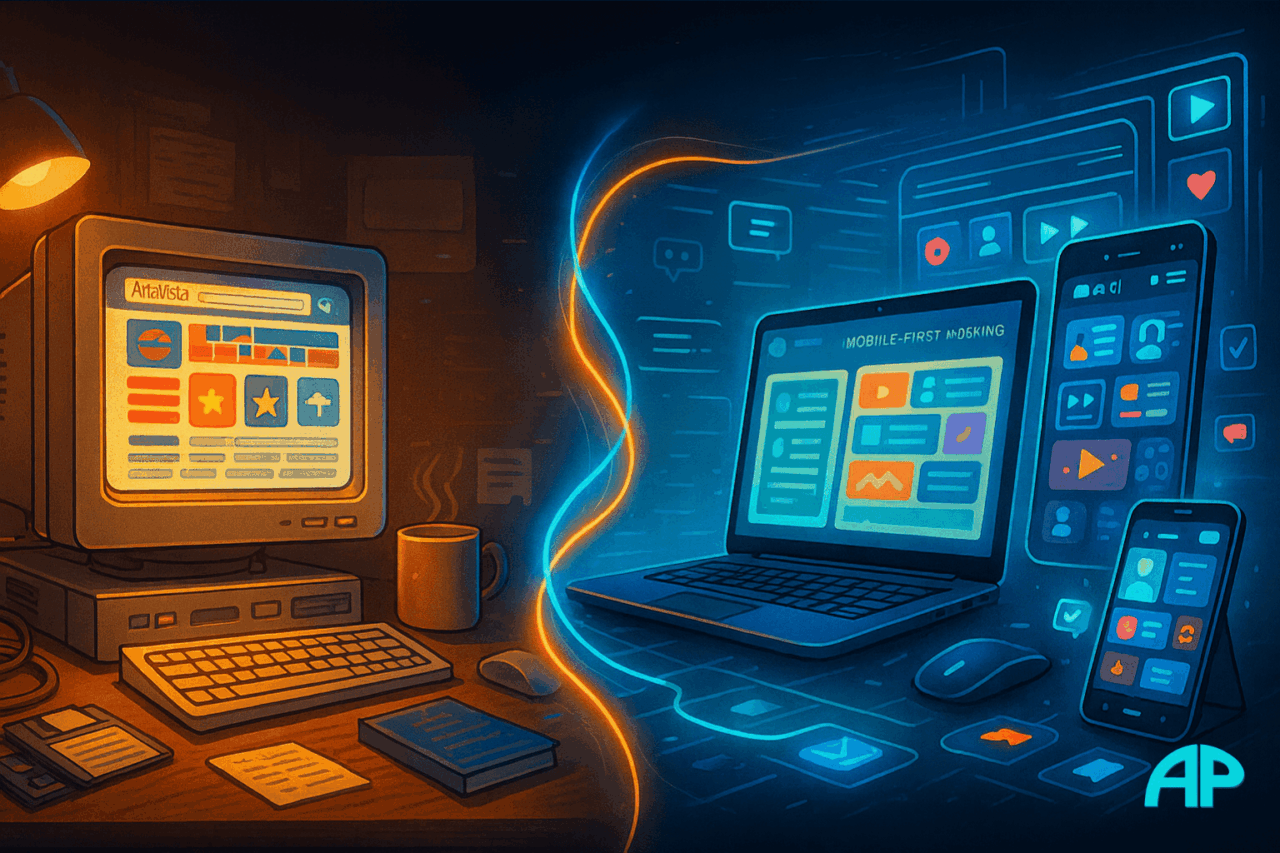
The History of the Internet in two very different worlds
Looking back, it’s wild to see just how far the history of the internet has come since 1998. In the early days, the web felt like a neighbourhood — small, personal, a little messy. Sites were built with love (and questionable design choices), search engines were still finding their footing, and the early days of SEO meant you could outsmart algorithms with a handful of tricks.
Today? The internet is a sprawling, always-on metropolis. The evolution of web design has given us sleek, responsive, mobile-first experiences. Google search history has moved from “submit your site” to AI-powered query predictions in milliseconds. The rise of social media platforms has made it possible to reach millions instantly — but also harder than ever to stand out. And now, AI and the future of the internet are redefining how content is created at a speed that makes even the dot-com boom look slow.
We’ve gained speed, reach, and unimaginable tools. But we’ve also lost some of that raw, hand-crafted magic from the early web. Back then, every site felt different. Today, the web is cleaner, faster, and more efficient — but sometimes it all feels the same.
The Road Ahead
The History of the Internet’s next chapter is still unwritten
If there’s one thing the history of the internet teaches us, it’s that nothing stays the same for long. We’ve gone from dial-up tones to instant AI responses in just over two decades — so trying to predict the next twenty years feels like guessing the weather in another galaxy.
Still, some trends are hard to ignore. The evolution of web design will likely lean even more toward immersive, personalised experiences — think VR storefronts, AR-enhanced browsing, and designs that adapt in real time based on your behaviour. Google search history could soon look unrecognisable as search engines integrate AI assistants that anticipate what you want before you even type it.
The rise of social media platforms will continue, but they may morph into hybrid spaces — part entertainment, part marketplace, part AI companion. And of course, AI and the future of the internet will remain the big wild card. Will it make the web more creative and connected, or will it flood it with so much noise that human-made content becomes a rare gem?
One thing’s certain: just like in 1998, those who adapt, experiment, and stay curious will thrive. The tools will change, the rules will change, but the core opportunity remains the same — to build, connect, and create something worth sharing.
So here’s to the next chapter. Who knows? In twenty years, we might look back on today as the quaint, clunky, early days of whatever comes next.
FAQ: History of the Internet
1. When did the history of the internet really begin?
While the internet’s foundations go back to ARPANET in the late 1960s, the commercial and public history of the internet took off in the early 1990s, exploding further with Google’s launch in 1998.
2. What were the early days of SEO like?
In the early days of SEO, ranking meant stuffing keywords onto a page, hiding text in the background, and manually submitting sites to search engines. It was the Wild West compared to today’s algorithm-driven optimisation.
3. How has the evolution of web design changed the user experience?
The evolution of web design has taken us from static, cluttered layouts to sleek, mobile-first, responsive designs that adapt to any device and prioritise user experience.
4. When did mobile-first design become important in the history of the internet?
Mobile-first design became essential after 2015 when Google made mobile-friendliness a ranking factor, marking a major turning point in the history of the internet.
5. How has Google search history reflected changes in user behaviour?
Google search history shows a shift from basic keyword queries in the 2000s to conversational and AI-assisted searches today, reflecting evolving user habits.
6. What impact did the rise of social media platforms have on the internet?
The rise of social media platforms turned the internet into a global conversation hub, creating new opportunities for connection, marketing, and influence — while also sparking debates about privacy and misinformation.
7. How has AI changed the history of the internet?
AI and the future of the internet are now inseparable. AI creates content, designs websites, curates social feeds, and shapes how we search, interact, and consume information.
8. What did we lose as the internet evolved?
We’ve gained speed, reach, and incredible tools, but lost the raw, hand-crafted charm of the early web, where every site felt personal and unique.
9. Will AI make traditional SEO obsolete?
Not entirely. While AI will automate many SEO tasks, human strategy, creativity, and trust-building will remain critical in the evolving history of the internet.
10. What might the next decade of the internet look like?
Expect deeper AI integration, immersive VR/AR experiences, and decentralised platforms — alongside ongoing debates about trust, privacy, and control.


